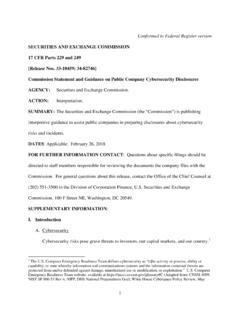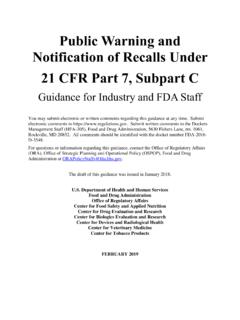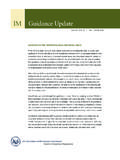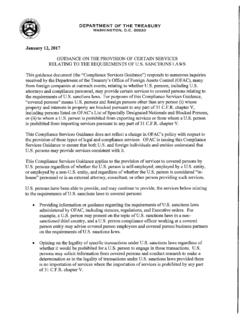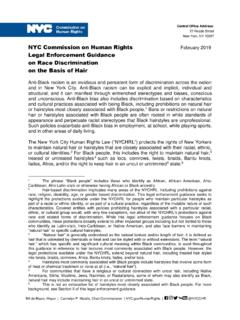Transcription of Guidance on the preparation of public versions of ...
1 Guidance on the preparation of public versions of commission Decisions adopted under Articles 7 to 10, 23 and 24 of Regulation 1/2003 1. Decisions are taken as openly as possible within the European Union, according to the second subparagraph of Article 1 of the Treaty on European Union. This principle is reflected in Article 15 of the Treaty on the Functioning of the European Union ("TFEU"), which requires the Union's institutions to conduct their work as openly as possible. The ability of the institutions to make acts which they adopt public is therefore the rule. EU law may provide for exceptions to this rule and prevent the disclosure of such acts or certain information contained therein.
2 1 Such exceptions include in particular the provisions ensuring compliance with the obligation of professional 2. In line with the general principles recalled above, the commission makes as much information as possible available to the public , and only refrains from disclosing information to the extent that this is covered by its duty of professional secrecy or other public policy exceptions. According to the case law, three cumulative conditions must be met in order for information to fall, by its nature, within the ambit of the obligation of professional secrecy and thus to enjoy protection against disclosure to the public : (i) that it is known only to a limited number of persons, (ii) that its disclosure is liable to cause serious harm to the person who has provided it or to third parties and (iii) that the interests liable to be harmed by disclosure are, objectively, worthy of 3.
3 Article 30 of Council Regulation (EC) No 1/20034 requires the commission to publish the decisions which it takes pursuant to Articles 7 to 10, 23 and 24. The publication shall state the names of the parties and the main content of the decision , including any penalties imposed. It shall have regard to the legitimate interest of undertakings in the protection of their business secrets and other confidential information. 4. In compliance with Article 30 of Council Regulation (EC) No 1/2003, the commission 1 See Judgment of the General Court of 28 January 2015, Akzo Nobel NV and Eka v commission , T-345/12, ECLI:EU:T:2015:50, paragraph 60, Judgment of the General Court of 28 January 2015, Evonik Degussa v commission , T-341/12, ECLI:EU:T:2015:51, paragraph 89 and Judgment of the Court of First Instance of 30 May 2006, Bank Austria Creditanstalt v commission , T-198/03, ECLI:EU:T:2006:136, paragraph 69.
4 2 See Article 339 TFEU. The relevant provisions on professional secrecy in the context of antitrust proceedings are Article 28(2) of Council Regulation (EC) No 1/2003 of 16 December 2002 on the implementation of the rules on competition laid down in Articles 81 and 82 of the Treaty (OJ L 1, , p. 1) and Article 16(1) of commission Regulation (EC) No 773/2004 of 7 April 2004 relating to the conduct of proceedings by the commission pursuant to Articles 81 and 82 of the EC Treaty, (OJ L 123, , p. 18). 3 Judgment of the Court of First Instance of 30 May 2006, Bank Austria Creditanstalt v commission , T- 198/03, ECLI:EU:T:2006:136, paragraph 71, Judgment of the General Court of 28 January 2015, Evonik Degussa v commission , T-341/12, ECLI:EU:T:2015:51, paragraph 94 and Judgment of the General Court of 28 January 2015, Akzo Nobel NV and Eka v commission , T-345/12, ECLI:EU:T:2015:50, paragraph 65.
5 4 Council Regulation (EC) No 1/2003 of 16 December 2002 on the implementation of the rules on competition laid down in Articles 81 and 82 of the Treaty (OJ L 1, , p. 1). publishes a non-confidential summary of the decisions taken pursuant to Articles 7 to 10, 23 and 24, together with the final report of the Hearing Officer and the opinion of the Advisory Committee5 in the Official Journal of the European Union (OJ).6 In line with established practice, it also publishes a non-confidential text of the decision ( public version) on the DG Competition The documents published in the OJ are made available on the DG Competition website as 5. The General Court has confirmed the right of the commission to publish its decisions in the OJ and on the DG Competition Addressees of decisions adopted under Articles 7 to 10, 23 and 24 of Council Regulation (EC) No 1/2003 cannot prevent the commission from publishing such decisions.
6 It is the commission 's practice to publish as much detail as possible in order to allow those interested to understand fully the reasoning behind such a decision . 6. This Guidance outlines: a) what undertakings can claim for redaction as business secrets and confidential information and what is usually not considered to be confidential information; b) how confidentiality for business secrets and other confidential information can be claimed; c) what the commission usually redacts on its own initiative in the public version of a decision ; and d) the procedure that should be followed to settle confidentiality claims in the context of publication of the commission decision and related publications.
7 7. This Guidance only concerns the preparation of the public version of commission decisions and related publications and does not cover the preparation of non-confidential submissions by undertakings in the context of the commission 's access to file procedure. 5 If the Advisory Committee so recommends, see Article 14(6) of Council Regulation (EC) No 1/2003. 6 Article 17(3) of the decision of the President of the European commission of 13 October 2011 on the function and terms of reference of the hearing officer in certain competition proceedings, (OJ L 275, ) p. 29 ("Hearing Officer Terms of Reference"). 7 See paragraph 149 of the commission notice on best practices for the conduct of proceedings concerning Articles 101 and 102 TFEU, OJ, C 308, p.
8 6-32. 8 See the DG Competition website: 9 See Judgment of the Court of First Instance of 30 May 2006, Bank Austria Creditanstalt v commission , T- 198/03, ECLI:EU:T:2006:136, paragraph 77, Judgment of the General Court of 28 January 2015, Akzo Nobel NV and Eka v commission , T-345/12, ECLI:EU:T:2015:50, paragraph 90 and Judgment of the General Court of 28 January 2015, Evonik Degussa v commission , T-341/12, ECLI:EU:T:2015:51, paragraph 120. 1. WHAT CAN AND CANNOT BE CLAIMED FOR REDACTION 8. Undertakings can claim confidentiality for business secrets and other confidential information that should not appear in the public version of the commission decision and in the related Business secrets 9.
9 Business secrets are confidential information about an undertaking's business activity the disclosure of which could result in serious harm for the same The interests liable to be harmed by disclosure must, objectively, be worthy of 10. Examples of information that may qualify as business secrets in antitrust decisions include: technical and/or financial information relating to an undertaking's know-how; margins calculations and price structure; production secrets and processes; supply sources; quantities produced and sold; market shares; customers and distributors lists; marketing plans; cost and methods of assessing costs; and sales strategy. Other confidential information 11.
10 Other confidential information13 is information other than business secrets, insofar as its disclosure would significantly harm a person or undertaking. The interests liable to be harmed by disclosure must, objectively, be worthy of Depending on the specific circumstances of each case, this may include information that would enable the parties to identify complainants or other third parties where those have a justified wish to remain anonymous. Information not considered confidential 12. The assessment whether a piece of information constitutes a business secret or other confidential information is carried out by the commission on a case-by-case basis. Generally, information that is not covered by the above definitions of business secrets and other confidential information will not be considered confidential.










